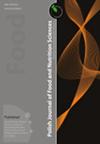添加黄粉虫食虫粉对海绵蛋糕感官接受度、理化性质及质地的影响
IF 2.3
4区 农林科学
Q3 FOOD SCIENCE & TECHNOLOGY
引用次数: 6
摘要
本研究的目的是评估使用昆虫粉补充海绵蛋糕的可能性。测定了消费者接受度、化学成分、质地特性和微生物特性。粉虫粉的添加显著增加了营养成分,尤其是蛋白质、灰分、脂质和膳食纤维的含量。肉糜粉影响了颜色参数以及质地特性。脂肪酸分布以单不饱和脂肪酸为主,小麦粉海绵蛋糕为9.72 g/100 g,粉虫粉添加量为20%的海绵蛋糕为41.82 g/100 g。与小麦粉和海绵蛋糕相比,粉虫粉的氨基酸特征是必需氨基酸含量显著较高。除赖氨酸是所有样品中的限制性氨基酸外,补充海绵蛋糕的蛋白质具有良好的营养价值。然而,与粉虫和小麦海绵蛋糕的30.38%相比,限制氨基酸指数分别为63.04-63.10%。昆虫粉的存在降低了所获得的海绵蛋糕的感官特性,无论其数量如何。粉虫面粉的添加有助于在烘焙当天和储存30天期间显著降低海绵蛋糕的硬度和可断裂性。昆虫粉的添加并没有降低最终产品的微生物安全性。研究结果表明,粉虫面粉有可能用于糖果产品的生产。本文章由计算机程序翻译,如有差异,请以英文原文为准。
Effect of the Addition of Edible Insect Flour from Yellow Mealworm (Tenebrio molitor) on the Sensory Acceptance, and the Physicochemical and Textural Properties of Sponge Cake
The aim of this study was to evaluate the possibility of using insect flour for sponge cake supplementation. Consumer acceptance, chemical com - position, textural properties, and microbiological characteristics were determined. The addition of mealworm flour significantly increased the content of nutrients, especially protein, ash, lipid, and dietary fiber. Mealworm flour influenced the color parameters as well as textural properties. The fatty acid profile was dominated by monounsaturated fatty acids, ranging from 9.72 g/100 g for wheat flour sponge cake to 41.82 g/100 g for sponge cake with 20% addition of mealworm flour. The amino acid profile of mealworm flour was characterized by a significantly higher content of essential amino acids compared to wheat flour and sponge cakes. Sponge cake supplementation resulted in a good nutritional value of protein except for lysine which was the limiting amino acid in all samples. However, the limiting amino acid index was 63.04-63.10% compared to 30.38% for the mealworm and wheat sponge cake, respectively. The presence of insect flour reduced the organoleptic properties of the obtained sponge cakes, regardless of its quantity. The addition of mealworm flour contributed to a significant reduction in the hardness and fracturability of the sponge cakes on the baking day and dur - ing the 30-day storage. Insect flour addition did not reduce the microbiological safety of the final product. The study results indicate the possibility of using mealworm flour in the production of confectionery products.
求助全文
通过发布文献求助,成功后即可免费获取论文全文。
去求助
来源期刊

Polish Journal of Food and Nutrition Sciences
FOOD SCIENCE & TECHNOLOGY-
CiteScore
4.30
自引率
12.50%
发文量
25
审稿时长
20 weeks
期刊介绍:
The Polish Journal of Food and Nutrition Sciences publishes original, basic and applied papers, reviews and short communications on fundamental and applied food research in the following Sections:
-Food Technology:
Innovative technology of food development including biotechnological and microbiological aspects
Effects of processing on food composition and nutritional value
-Food Chemistry:
Bioactive constituents of foods
Chemistry relating to major and minor components of food
Analytical methods
-Food Quality and Functionality:
Sensory methodologies
Functional properties of food
Food physics
Quality, storage and safety of food
-Nutritional Research Section:
Nutritional studies relating to major and minor components of food (excluding works related to questionnaire
surveys)
-“News” section:
Announcements of congresses
Miscellanea
 求助内容:
求助内容: 应助结果提醒方式:
应助结果提醒方式:


